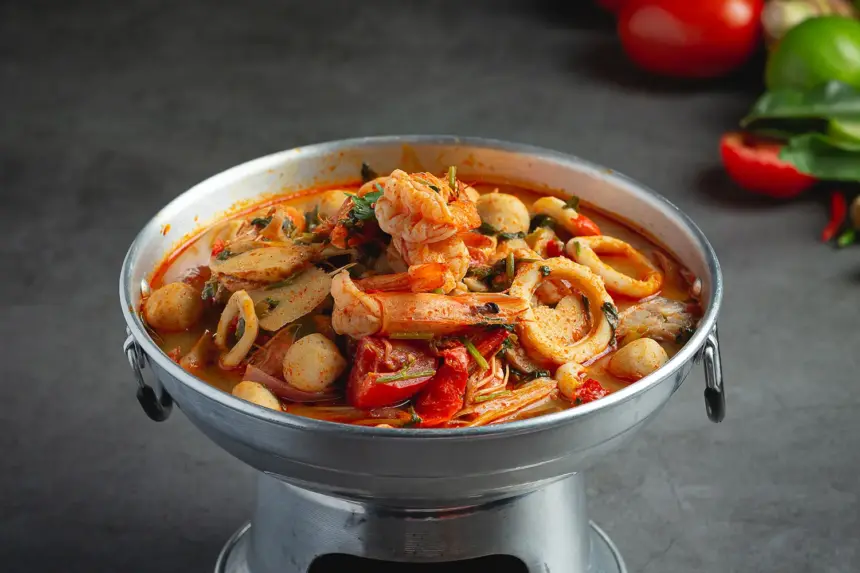Thai Food: Tom Yum Goong – A Deep Dive into Thailand’s Most Iconic Soup
Thai cuisine is globally renowned for its perfect harmony of flavors, and Tom Yum Goong (ต้มยำกุ้ง), a hot and sour shrimp soup, epitomizes this. With its bold combination of spicy, sour, salty, and savory flavors, Tom Yum Goong is a dish that excites the palate and offers a true taste of Thailand’s culinary heritage. This beloved soup not only holds a special place in Thai cuisine but also in the hearts of those who have experienced its distinct and unforgettable flavors.
In this article, we will explore the history, ingredients, preparation, variations, and cultural significance of Tom Yum Goong, providing an in-depth look at why it is considered one of the most iconic dishes in Thailand.
The History of Tom Yum Goong
Tom Yum Goong’s origins are deeply rooted in Thailand’s history and geography. Thailand’s tropical climate and fertile lands provide a wealth of fresh ingredients, including herbs, seafood, and spices, all of which play crucial roles in the creation of Tom Yum. The dish is believed to have originated in central Thailand, where the Chao Phraya River provides an abundance of freshwater shrimp, one of the key components of the dish.
The word “Tom” refers to the boiling process, while “Yum” means “mixing,” which perfectly describes the preparation of this soup. “Goong” translates to “shrimp,” highlighting the star ingredient in this version of Tom Yum. Although there are other variations of the soup (such as those made with chicken or pork), shrimp remains the most popular and widely known.
Over the years, Tom Yum Goong has become synonymous with Thai cuisine, recognized globally for its distinctive combination of flavors and aromatic qualities. As Thai food spread around the world, Tom Yum Goong became one of the country’s most famous culinary exports, beloved for its unique taste and ability to capture the essence of Thai cooking in one bowl.
Essential Ingredients in Tom Yum Goong
The success of Tom Yum Goong lies in its ingredients, which each contribute to the soup’s intense and multi-layered flavors. These ingredients are staples of Thai cooking, reflecting the country’s rich biodiversity and culinary traditions.
- Shrimp (Goong): The primary protein in Tom Yum Goong is fresh shrimp, preferably with the shell and head intact. The shrimp heads are often used to enrich the broth, adding a deep, briny flavor that enhances the overall richness of the soup.
- Lemongrass: One of the most important aromatics in Thai cuisine, lemongrass imparts a citrusy fragrance and slight bitterness to the soup. It is typically bruised and cut into chunks to release its essential oils during cooking.
- Galangal: Often mistaken for ginger, galangal is a key ingredient in Tom Yum Goong, providing a peppery, slightly pine-like flavor. Its distinct taste differentiates the soup from other similar dishes, like ginger-based soups.
- Kaffir Lime Leaves: These glossy, dark green leaves contribute a zesty aroma and slightly floral flavor. They are usually torn or bruised before being added to the soup to release their essential oils, which permeate the broth.
- Chilies: Fresh Thai bird’s eye chilies add heat to the dish. They can be adjusted according to taste, with some versions of Tom Yum Goong being incredibly fiery while others are more moderately spiced.
- Fish Sauce: This pungent condiment, made from fermented fish, provides the salty, umami depth to Tom Yum Goong. It’s an essential component of Thai cooking, balancing the sharpness of the citrus ingredients.
- Lime Juice: Fresh lime juice adds the sour element to the soup, bringing brightness and acidity that cuts through the richness of the broth. The lime juice is typically added at the end of cooking to preserve its fresh, tangy flavor.
- Mushrooms: Typically, straw mushrooms or oyster mushrooms are used in Tom Yum Goong. They add a subtle earthiness and texture to the soup, complementing the shrimp and the broth.
- Cilantro (Coriander): Fresh cilantro leaves are used as a garnish, adding a herbal, slightly citrusy note that complements the other flavors in the soup.
- Optional Ingredients: Some variations of Tom Yum Goong include coconut milk or evaporated milk, which mellows the spice and adds a creamy texture to the soup. This version is known as Tom Yum Goong Nam Khon.
The Flavor Profile of Tom Yum Goong
What makes Tom Yum Goong so special is its carefully balanced flavor profile. Each ingredient contributes to a different layer of taste, resulting in a soup that is incredibly complex yet perfectly harmonious. Here’s a breakdown of the key flavors:
- Spicy: The heat in Tom Yum Goong comes from the fresh chilies, which give the soup its signature kick. Thai bird’s eye chilies are small but pack a punch, providing a fiery undertone that invigorates the taste buds.
- Sour: Lime juice and lemongrass contribute to the soup’s sharp, tangy flavor. The sourness is what makes Tom Yum Goong so refreshing and light, cutting through the richness of the broth.
- Salty: Fish sauce is the primary source of saltiness in the soup, adding depth and umami. It complements the sour and spicy notes, rounding out the flavor profile.
- Sweet: Although Tom Yum Goong is not typically a sweet dish, the natural sweetness of the shrimp and the subtle sweetness from the aromatics (like lemongrass and galangal) provide balance to the soup’s more aggressive flavors.
- Aromatic: The combination of lemongrass, kaffir lime leaves, and galangal gives Tom Yum Goong its characteristic aroma, which is both soothing and appetizing.
How Tom Yum Goong is Prepared
The preparation of Tom Yum Goong is relatively simple, but attention to detail is required to ensure the balance of flavors is just right. Here’s a step-by-step guide to making an authentic version of the dish:
- Prepare the Aromatics: Start by bruising the lemongrass stalks, tearing the kaffir lime leaves, and slicing the galangal. These aromatics will infuse the broth with their flavors as they simmer.
- Make the Broth: In a pot, bring water or chicken stock to a boil. Add the lemongrass, galangal, and kaffir lime leaves. Let these simmer for a few minutes to release their flavors into the broth.
- Add Shrimp and Mushrooms: Once the broth is fragrant, add the shrimp and mushrooms. If using shrimp with the heads and shells intact, let them simmer in the broth to release their natural sweetness.
- Season the Soup: Add fish sauce for saltiness and fresh chilies for heat. Adjust the amount of chilies based on your tolerance for spice.
- Finish with Lime Juice: Once the shrimp are cooked through, remove the soup from heat and stir in fresh lime juice. This preserves the bright, tangy flavor of the lime.
- Garnish and Serve: Serve the soup hot, garnished with fresh cilantro leaves and additional lime wedges. For a creamy version, stir in a splash of coconut milk or evaporated milk before serving.
Variations of Tom Yum
While Tom Yum Goong is the most famous version of the soup, there are several variations that use different proteins or additional ingredients. Some of the most popular include:
- Tom Yum Gai: This version uses chicken instead of shrimp. It follows the same basic recipe but has a slightly richer flavor due to the chicken broth.
- Tom Yum Pla: Made with fish, usually sea bass or snapper, this version is lighter than Tom Yum Goong and is often enjoyed in coastal regions of Thailand.
- Tom Yum Nam Khon: This variation includes coconut milk or evaporated milk, which adds creaminess and mellows the spice, making it a popular choice for those who prefer a less fiery soup.
Cultural Significance of Tom Yum Goong
Tom Yum Goong is more than just a popular dish; it’s a reflection of Thailand’s approach to food. Thai cuisine is built on the principles of balance, and this soup exemplifies that philosophy. Every bowl of Tom Yum Goong is a carefully crafted harmony of flavors, designed to engage all the senses.
In Thailand, food is often seen as a communal experience, and Tom Yum Goong is commonly shared among family and friends. Whether it’s enjoyed as part of a larger meal or as a comforting dish on its own, Tom Yum Goong holds a special place in Thai culture. It’s often served during festivals, family gatherings, and important occasions, symbolizing warmth, hospitality, and the joy of sharing food with loved ones.
Conclusion: Why You Must Try Tom Yum Goong
For anyone looking to experience the true essence of Thai cuisine, Tom Yum Goong is a must-try dish. It encapsulates the bold, vibrant, and harmonious flavors that define Thai food, all in one bowl. With its rich history, fragrant ingredients, and tantalizing flavor profile, Tom Yum Goong offers a culinary experience that is both authentic and unforgettable.
Whether you’re dining in Thailand or at a Thai restaurant abroad, Tom Yum Goong provides a window into the heart of Thai cooking. Its balance of spicy, sour, salty, and savory elements ensures that it remains a beloved dish for locals and visitors alike. So, the next time you’re in the mood for something exotic, comforting, and bursting with flavor, look no further than Tom Yum Goong—Thailand’s iconic soup.










